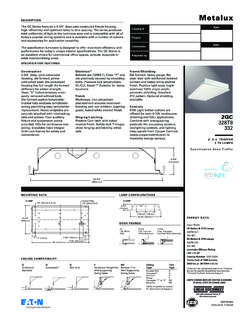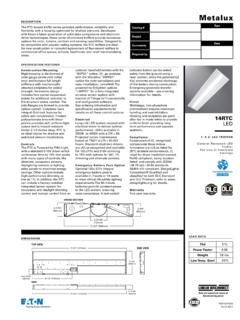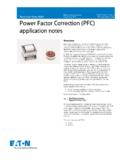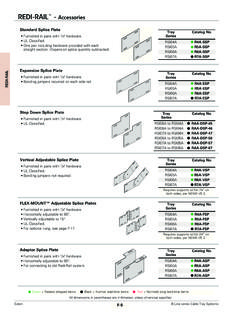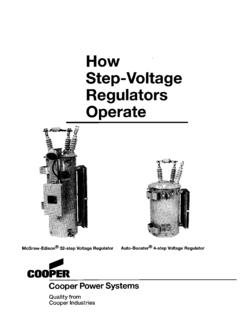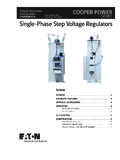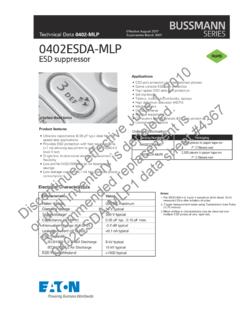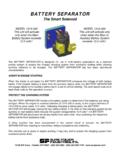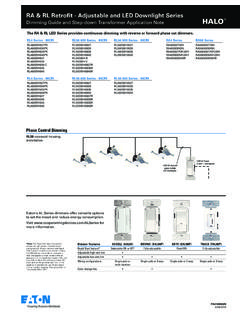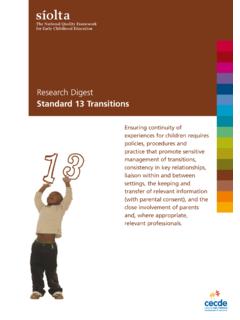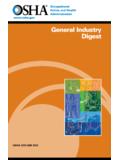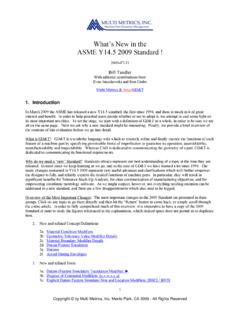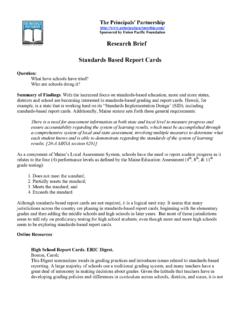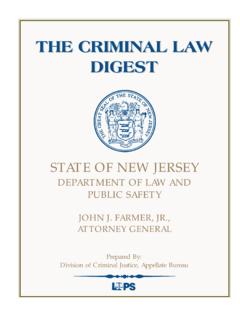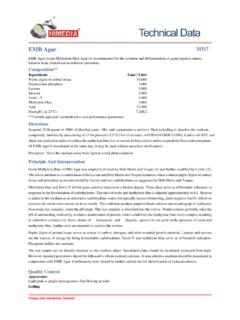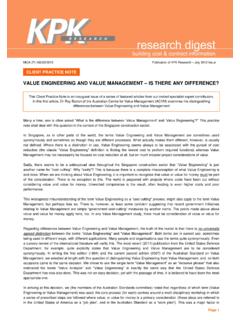Transcription of 2014 Code Digest - Cooper Industries
1 2014 code DigestArticle 500-516 of the National Electrical code with product recommendations for use in hazardous (classifi ed) code Digest2 2014 code Digest EATON S CROUSE-HINDS BUSINESSREPRINTED WITH PERMISSION FROM NFPA 70 - 2014 , NATIONAL ELECTRICAL code COPYRIGHT 2013, NATIONAL FIRE PROTECTION ASSOCIATION, QUINCY, MA. THIS MATERIAL IS NOT THE OFFICIAL POSITION OF THE NFPA ON THE REFERENCED SUBJECT, WHICH IS REPRESENTED ONLY BY THE STANDARD IN ITS ENTIRETY. EATON S CROUSE-HINDS BUSINESS 2014 code Digest 32014 code DigestREPRINTED WITH PERMISSION FROM NFPA 70 - 2014 , NATIONAL ELECTRICAL code COPYRIGHT 2013, NATIONAL FIRE PROTECTION ASSOCIATION, QUINCY, MA. THIS MATERIAL IS NOT THE OFFICIAL POSITION OF THE NFPA ON THE REFERENCED SUBJECT, WHICH IS REPRESENTED ONLY BY THE STANDARD IN ITS ENTIRETY.
2 EATON S CROUSE-HINDS BUSINESS 2014 code Digest CContents PageIntroduction ..1l. Classification of Hazardous A. The National Electrical code .. 2 Atmospheres B. Class I Atmospheric Hazards .. 2 C. Class II Atmospheric Hazards .. 2 D. Class III Atmospheric Hazards .. 2 E. Evaluation of Hazardous Areas .. 2II. Prevention of External Ignition and A. Enclosures .. 3 Explosion B. Purging/Pressurization Systems .. 3 C. Intrinsically Safe Equipment .. 3 Ill. Equipment for Hazardous Areas A. Switchgear and Industrial Controls.
3 4 B. Luminaires (Lighting Fixtures) .. 4 C. Motors and Generators .. 5 D. Plugs and Receptacles .. 6 E. Portable Devices .. 6IV. Wiring Methods and Materials A. Conduit .. 7 B. Seals for Conduit System .. 7 C. Mineral-Insulated Cable .. 8 D. Metal-Clad Cable .. 8 E. Tray Cable .. 8 F. Other Permitted Cables .. 8 G. Cable Sealing .. 8 H. Nonmetallic Conduit .. 8V. Maintenance Principles A. Electrical Circuits .. 9 B. Assembly or Disassembly of Enclosures .. 9 C. Cover Attachment Screws.
4 9 D. Cleaning and Lubrication .. 9 E. Shaft and Bearing 9 F. Corrosive Locations .. 9 G. Portable Equipment .. 9 H. Overall Safety .. 9 I. Plug-in Replacement Units .. 9 J. Maintenance .. 9VI. Selected Articles from the National 500 Hazardous (Classified) Locations .. 10 Electrical code 2014 501 Class I Locations .. 18 502 Class II Locations .. 36 503 Class III Locations .. 45 504 Intrinsically Safe Systems .. 49 505 Class I, Zone 0, 1 and 2 Locations .. 52 506 Zone 20, 21, and 22 Locations for Combustible Dusts, Ignitible Fibers/Flyings .. 68 510 Hazardous (Classified) Locations Specific .. 75 511 Commercial Garages, Repair and Storage .. 75 513 Aircraft Hangars .. 78 514 Motor Fuel Dispensing Facilities.
5 80 515 Bulk Storage Plants .. 85 516 Spray Application, Dipping and Coating Processes .. 90 Appendices I & II Hazardous Substances Used in Business and Industry ..100-104 I Table I Gases and Vapors Hazardous Substances Used in Business and Industry .. 100 II Table II Dusts Hazardous Substances Used in Business and Industry .. 104 III Selection of Seals and Drains .. 105 IV Installation Diagram for Sealing .. 109 V Diagram for Class I, Zone 1 Power and Lighting Installation .. 110 VI Diagram for Class I, Division 1 Lighting Installation .. 111 VII Diagram for Class I, Division 1 Power Installation .. 112 VIII Diagram for Class I, Division 2 Power and Lighting Installation .. 113 IX Diagram for Class II Lighting Installation .. 114 X Diagram for Class II Power Installation .. 115 XI Quick Selector Electrical Equipment for Hazardous Locations.
6 116 Hazardous Area Reference Global reference guide for potentially explosive atmospheres and hazardous locations .. 117 Article 500 Hazardous(Classified) Locations2014 code Digest4 2014 code Digest EATON S CROUSE-HINDS BUSINESSREPRINTED WITH PERMISSION FROM NFPA 70 - 2014 , NATIONAL ELECTRICAL code COPYRIGHT 2013, NATIONAL FIRE PROTECTION ASSOCIATION, QUINCY, MA. THIS MATERIAL IS NOT THE OFFICIAL POSITION OF THE NFPA ON THE REFERENCED SUBJECT, WHICH IS REPRESENTED ONLY BY THE STANDARD IN ITS ENTIRETY. EATON S CROUSE-HINDS BUSINESS 2014 code Digest 52014 code DigestREPRINTED WITH PERMISSION FROM NFPA 70 - 2014 , NATIONAL ELECTRICAL code COPYRIGHT 2013, NATIONAL FIRE PROTECTION ASSOCIATION, QUINCY, MA.
7 THIS MATERIAL IS NOT THE OFFICIAL POSITION OF THE NFPA ON THE REFERENCED SUBJECT, WHICH IS REPRESENTED ONLY BY THE STANDARD IN ITS ENTIRETY. EATON S CROUSE-HINDS BUSINESS 2014 code Digest 1 ForewordEaton s Crouse-Hinds has revised its code Digest for 2014 to meet the needs of design personnel for a ready reference to equipment and installation ideas in hazardous locations. Selected Articles from the National Electrical code have been explained with diagrams and photographs of electrical hardware taken from our Eaton s Crouse-Hinds Product Catalog. Exhaustive laboratory testing and extensive research, development and field experience have proven that these items meet or exceed the requirements set forth by the National Electrical code and Underwriters Laboratories Inc. This latest revision to the series of Eaton s Crouse-Hinds service-oriented bulletins reflects the most recent changes in the National Electrical code in Articles 500 through 516.
8 Reproduction of these Articles has been made with the permission of the National Fire Protection of recommended power and lighting installations have been included in Appendices V, VI, VII, VIII, IX and X to assist engineers involved in the design of these systems for hazardous locations. A Quick-Selector Guide for electrical equipment used for Class I, Class II and Class III installations is included in Appendix XI. Tables included are those of most frequent applicability and usage. Photographs of actual application of Eaton s Crouse-Hinds products for a variety of environments have been added for clarity and specific sincerely hope that this Digest will be of value to you. Feel free to call on your Eaton s Crouse-Hinds representative for personal assistance in your installation planning at any time. A. The National Electrical code and Underwriters Laboratories NEC is a product of the National Fire Protection Association.
9 It is considered the definitive classification tool and contains explanatory data about flammable gases and combustible dusts as it may apply to storage areas, garages, gasoline stations and other facilities where flammable or combustible materials are found. Specific installation practices have been set up for heavier-than-air vapors. In the case of hydrogen or other gas which has a low vapor density and is used indoors, the most hazardous concentrations are likely to be in the upper portion of the states, municipalities and public service companies use the NEC as a requirement for their Laboratories Inc. (UL), Canadian Standards Association (CSA), Factory Mutual (FM), and Intertek (ETL), are independent organizations that test for public safety. Their function is to determine whether or not devices and equipment submitted to them are safe and can be used in the NEC category for which they were designed.
10 To do this, these agencies maintain extensive laboratory and testing is not the function of these agencies to perform actual enforcement of the National Electric code . However, as previously indicated, inspection authorities use the certifications and listings from these agencies in carrying out their inspections of hazardous Combustion basic conditions must be satisfied for a fire or explosion to occur:1. A flammable liquid, vapor or combustible dust must be present in sufficient The flammable liquid, vapor or combustible dust must be mixed with air or oxygen in the proportions required to produce an explosive A source of energy must be applied to the explosive applying these principles, the quantity of the flammable liquid or vapor that may be liberated and its physical characteristics must be from flammable liquids also have a natural tendency to disperse into the atmosphere, and rapidly become diluted to concentrations below the lower flammable limit, particularly when there is natural or mechanical possibility that the gas concentration may be above the upper flammable limit does not afford any degree of safety.
